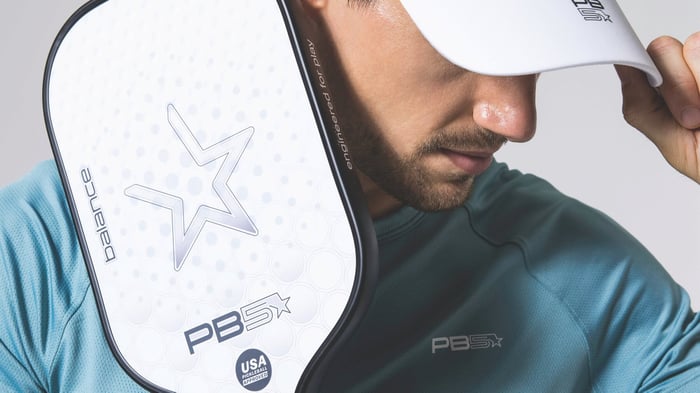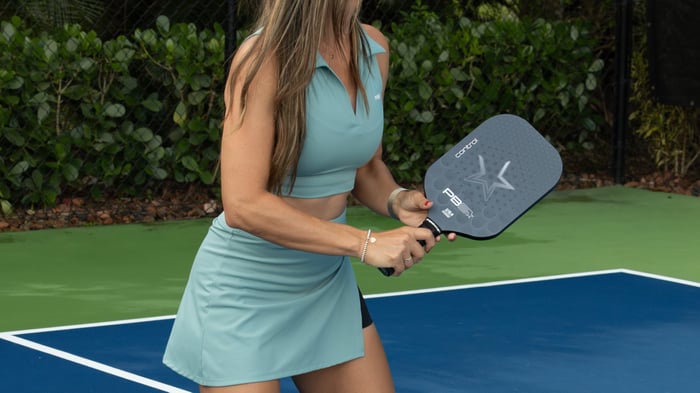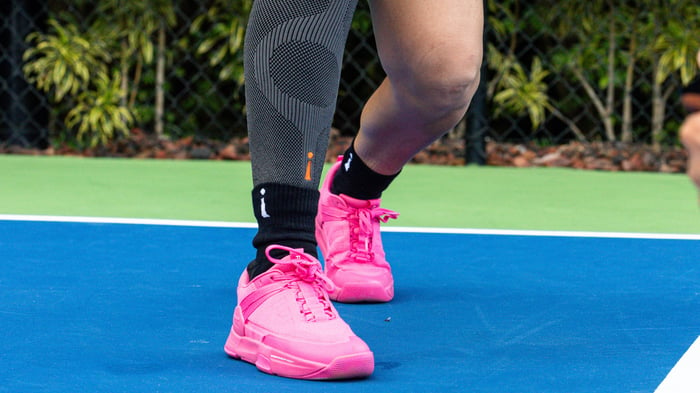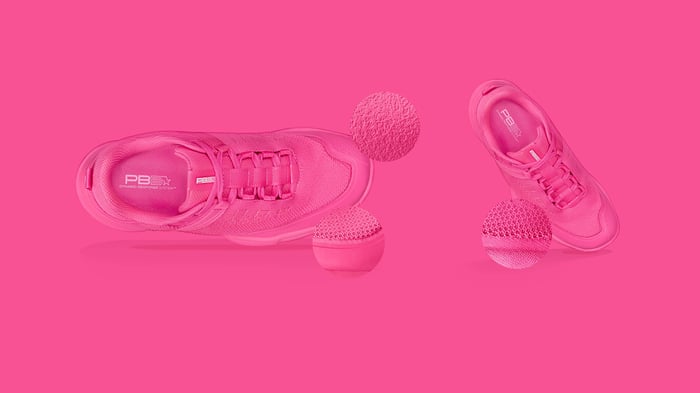Key takeaways:
Pickleball paddle materials like polymer cores and graphite or carbon fiber faces influence how your shots perform, from spin and control to overall power.
Choosing between polymer, Nomex, or aluminum cores helps align your paddle with your playing style, from finesse and control to explosive baseline shots.
Surface materials like graphite, fiberglass, and carbon fiber offer distinct combinations of touch, power, and durability that can give you an advantage in fast-paced matches.
Did you know that the materials in your pickleball paddle can be the difference between a good shot and a great one? From graphite faces as thin as mere millimeters to innovative core materials like carbon fiber, your paddle's construction is key to unlocking your potential on the court. Understanding what pickleball paddles are made of is essential for players who want to match their paddle to their technique and playing goals.
At PB5star, we're dedicated to crafting high-quality gear that takes your pickleball experience to new heights. Our paddles feature premium materials like graphite, carbon fiber, and fiberglass, chosen for their strength, durability, and game-enhancing properties. Carbon fiber, in particular, is renowned for its exceptional benefits on the court. Ready to boost your skills and join the PB5star community? Explore our collection of meticulously designed paddles to find your perfect match.
The anatomy of a pickleball paddle
Ever wondered “How is a pickleball paddle made?” Let's break it down into three main parts: the core, face, and edge guard. Each of these plays a big role in how your paddle performs when you're on the court.
Think of the core as the heart of your paddle. It's sandwiched between the face layers and largely determines how your paddle feels and behaves during play. Most pickleball paddles today use a material called polypropylene (also known as Polymer or PP) for the core. This material is popular because it gives a nice mix of power and control that works well for players at all levels.
The face is the part of the paddle that hits the ball. Wrapped around the edge of your paddle is the edge guard. It's like a protective shield that keeps the core and face safe if you accidentally drop your paddle or bump it against something. Some paddles don't have edge guards to make them lighter, but many players like having that extra protection.
Now that you know the basics of paddle anatomy, let's dive deeper into the parts of a pickleball paddle. Understanding these materials can help you choose the perfect paddle for your game.
Understanding core materials
Ever wondered what gives your pickleball paddle its unique feel and performance? It's all in the core. Let's explore the main types of core materials and how they can elevate your game:
Play with confidence using polymer cores, the go-to choice for most pickleball paddles today. These cores provide exceptional durability and consistent performance, helping you maintain control throughout your matches. You'll appreciate the perfect balance of power and precision that polymer cores offer, allowing you to finesse your shots with ease.
Take your power game to the next level with Nomex cores. The unique honeycomb design maximizes energy transfer from your paddle to the ball, giving you that extra oomph on your shots. If you're looking to add some strength to your game without sacrificing control, a Nomex core might be your perfect match.
Enhance your finesse play with aluminum cores. While less common in modern paddles, these ultra-lightweight cores are ideal for players who prioritize precise shot placement. Keep in mind that pickleball paddle materials like aluminum may not offer the same power and durability as newer alternatives, so consider your playing style carefully.
Experience the future of pickleball with carbon fiber cores. Our advanced paddle designs integrate innovative carbon fiber technology, providing unmatched strength, responsiveness, and precision. These cutting-edge cores help you elevate your performance and reach new heights in the game.
Choosing the right core material depends on your playing style and preferences. Whether you're all about power, control, or a bit of both, there's a paddle core out there that's perfect for you. At PB5star, we're here to help you find that perfect match and elevate your pickleball experience.
Materials overview
Let’s dive into the world of pickleball paddle materials and discover how they can transform your pickleball game. Choosing the right surface material is key to aligning your paddle with your playing style and elevating your performance on the court.
The primary surface materials used in high-quality paddles include graphite, carbon fiber, fiberglass, and composite materials. Each one offers unique characteristics that enhance power, control, and spin during gameplay.
Graphite surfaces are the precision player’s dream. With an ultra-thin layer, graphite provides exceptional rigidity and stiffness, allowing for enhanced control and accuracy in your shots. This makes it ideal for players who value precision and finesse, as it helps place the ball exactly where you want it.
Composite surfaces are known for their versatility, often blending materials like fiberglass and carbon fiber to offer a balance between power and control. This combination makes pickleball paddle composite vs graphite options suitable for various playing styles, providing optimal performance for both powerful drives and delicate dinks.
Fiberglass surfaces, on the other hand, are designed to add significant power to your shots while maintaining excellent spin potential. This combination allows players to dominate the court with explosive shots and tricky spins. Fiberglass is also durable, ensuring your paddle withstands intense gameplay session after session.
Many consider carbon fiber to be the best material for pickleball paddle performance due to its lightweight feel, strength, and exceptional control. This makes carbon fiber paddles an excellent choice for players looking for an edge in their game.
Choosing the right surface material depends on your unique playing style. If you prioritize control and precision, graphite or carbon fiber paddles are ideal. For a balance of power and control, composite paddles offer the best of both worlds. If adding extra power to your game is your goal, fiberglass surfaces are the way to go.
Finding the right paddle is like finding an extension of your arm. By understanding how different materials affect gameplay, you’re one step closer to finding your perfect pickleball partner.
Aluminum vs graphite: A comparison
Selecting between aluminum vs graphite pickleball paddles is like choosing the right dance partner for your pickleball journey. Both have unique strengths, but which one will elevate your game and help you connect with your local pickleball community?
Here’s a side-by-side comparison to guide you toward your ideal paddle companion:
Criteria | Graphite Paddles | Aluminum Paddles |
Weight | Typically lighter, around 7-7.8 oz | Often heavier, usually 8–9 oz |
Control | Superior precision and touch | Solid control, good for soft shots |
Power | Moderate power, emphasizes finesse | Lower power; less pop off the face |
Durability | Excellent, resistant to wear | Decent, but core can dent with hard impacts |
Price | Generally higher | More affordable and budget-friendly |
Ideal Player | Advanced players, touch game enthusiasts | Recreational or beginner players |
Graphite paddles excel in control and precision, making them the preferred choice for advanced players who savor a finesse-based game. They are designed to give you an extra edge in shot placement and touch. On the other hand, aluminum paddles tend to be heavier with a honeycomb metal core, which gives them better control on soft shots but less power and less forgiveness for off-center hits. They're ideal for beginners or recreational players seeking a durable, affordable option for casual play.
Whether you’re just starting out or looking to add some power to your game, the right paddle can improve your performance and boost your confidence on the court. Take the time to explore your options and find the perfect paddle that matches your playing style, ensuring you get the most out of your pickleball experience.
How are paddles made?
From the inner core to the outer face, and from edge protection to ergonomic handle design, each element plays a vital role. Here’s a look at how modern pickleball paddles are made, from raw materials to game-ready equipment. This breakdown not only helps players understand construction but also guides them in learning what is the best material for pickleball paddles based on performance and play style.
Core fabrication
Most pickleball paddles begin with a honeycomb core made from materials like polymer, aluminum, or Nomex. This core is carefully cut to the desired shape and thickness, which plays a significant role in determining the paddle’s overall weight, stiffness, and responsiveness during play.
Surface layer application
Once the core is prepared, a face material, typically graphite, fiberglass, or carbon fiber, is applied to both sides. This surface layer is bonded to the core using a heat-and-adhesive process known as lamination, which ensures durability and enhances the paddle's playing characteristics.
Edge guard installation
To protect the paddle from chips, cracks, and general wear, an edge guard is installed around its perimeter. This guard is usually made of plastic or rubber and adds structural integrity while helping the paddle withstand regular impact with the ground or other paddles.
Handle construction
The handle is constructed separately and then attached to the paddle body. It is wrapped in grip tape to provide comfort, stability, and control for the player. Some handles also incorporate extra cushioning or sweat-absorbing materials to enhance grip during intense matches.
Finishing touches
Finally, the paddle is trimmed and polished to achieve a smooth, professional finish. It’s then branded with decals or printed graphics for visual appeal. Before reaching the shelves, each paddle undergoes a series of quality control checks to ensure it meets standards for weight, balance, and performance.
Key parts of a paddle
Understanding the anatomy of a pickleball paddle can help you make a more informed decision:
Core: The “guts” of the paddle, usually made from aluminum, Nomex, or polymer, affect power and feel.
Face: The hitting surface; common materials include graphite (light, precise), fiberglass (powerful), and carbon fiber (durable and balanced).
Edge guard: Protects the perimeter from wear and tear. Some paddles have edgeless designs for a larger hitting surface.
Handle: Varies in length and grip circumference. Some mimic a tennis racquet feel, others are shorter for quicker wrist action.
Grip: Usually wrapped with moisture-wicking material for comfort and slip resistance. Can be replaced or customized.
Frequently asked questions about pickleball paddles
How to choose a pickleball paddle?
When buying a pickleball paddle, it’s important to choose a paddle based on your skill level, play style, and comfort. Beginners should opt for lightweight, affordable paddles with good control, while advanced players may prefer paddles with added power or precision. How to choose a pickleball paddle is a common question for new players, and the answer often comes down to trying a few options that match your goals.
How is a pickleball paddle made?
Paddles are made by bonding a core with a face material like graphite or fiberglass. After lamination, a handle is added and wrapped for comfort, and an edge guard is installed for protection. The paddle is then polished, branded, and tested before it’s ready for play.
What is the best material for pickleball paddles?
The best paddle material depends on your goals. Graphite is light and precise, fiberglass offers power, and carbon fiber blends control with durability. Aluminum cores give solid control, while polymer cores provide a softer, quieter feel; great for all-around use or noise-sensitive courts.
Why PB5star should be your go-to for pickleball gear
Ever wondered how your paddle's materials can level up your game? From graphite faces to carbon fiber cores, each component plays a crucial role in your performance.
At PB5star, we’re obsessed with crafting gear that helps you play your best. Our paddles combine premium materials that give you a competitive edge, whether you’re just starting out or gunning for the top spot in your local league.
One of our standout options is the Control paddle, designed with a polymer honeycomb core and a carbon face. This combination offers exceptional precision, giving you the touch and control needed to place shots exactly where you want them.
For those who seek a balance between power and control, our Balance paddle features a fiberglass composite face paired with a polymer honeycomb core. This construction provides the perfect blend of strength and finesse, making it versatile for various playing styles.
Check our collection and discover how the right gear can transform your game. And here’s some exciting news – we’re expanding our lineup to include footwear, so you’ll soon be covered from head to toe with PB5star quality.
Join our community today and become part of a family that’s all about playing better, looking great, and having a blast on the court. Let’s take your pickleball experience to new heights together!







